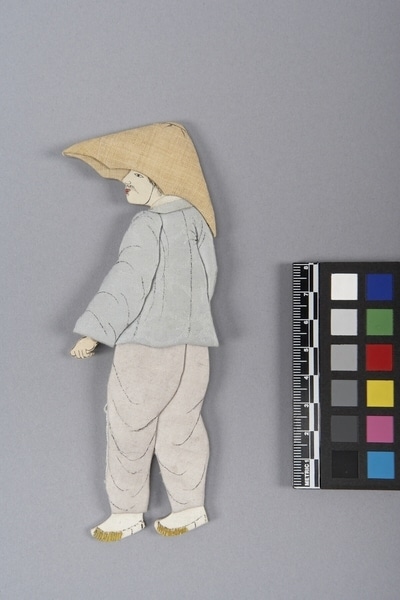Doll Item Number: Ed1.148 from the MOA: University of British Columbia

Description
Figure representing a person on a flat backing of white paper. Rear view is depicted with the face turned to the left side of the figure which is made of cloth lightly padded to give a three-dimensional effect having each portion made of a separate piece of cloth with painted details. Hands are made of paper. Face is made of white silk. Wearing a large hat shaped like a rounded triangle with an apex at the top, and a scalloped rim of dark yellow linen, a loose light blue silk jacket, loose grey-beige cotton trousers, and yellow sandals. Two pieces of white flannel edged with light green silk thread with a loop of the same thread at the top are sewn to the paper backing.
History Of Use
Figure represents a Korean man, either a farmer wearing a rain hat or a bullock-driver. His clothes, which would be of cotton, his straw sandals, and his large hat are characteristic of bullock-drivers in the late 19th century; also worn by men in mourning and Buddhist monks. Such figures were made during the time when Korea was first open to the outside world (after the mid 1890s), probably as gifts to present to missionaries or other visitors from foreign countries. Flat dolls like these were very popular during the period 1910-20. Before that time, shamans made dolls that they sold to their clients, as images of those the clients wanted to exorcise. Simple dolls were made of straw for children to play with. After Korea opened, people began to see dolls as artistic objects. They were made in workshops by masters, using authentic fabrics whenever possible, as their purpose was to introduce foreigners to Korean society. Such clothes and straw shoes were worn by farmers when going outdoors. The large hat served to protect them from the rain or sun. When working, they would wrap their trousers “Ba-ji” at the ankles with wrappers.
Narrative
Collected by J. H. Morris while he was chief engineer for Seoul Railway, Korea.
Specific Techniques
The clothing was stitched around the edge and then a layer was added inside the clothing. Each section was separately applied and pasted in place. The details were finely painted.
Item History
- Made in Korea during 1910
- Collected between 1910 and 1939
- Owned by Marion Stephan before August 1964
- Received from Marion Stephan (Donor) during August 1964
What
- Name
- Doll
- Identification Number
- Ed1.148
- Type of Item
- doll
- Material
- paper, silk fibre, cotton fibre, hemp fibre, paint and paste adhesive
- Manufacturing Technique
- spun, woven, cut, painted, sewn and pasted
- Overall
- height 15.5 cm, width 5.8 cm, depth 0.9 cm
Who
- Culture
- Korean
- Previous Owner
- Marion Stephan
- Received from
- Marion Stephan (Donor)
Where
- Holding Institution
- MOA: University of British Columbia
- Made in
- Korea
When
- Creation Date
- during 1910
- Collection Date
- between 1910 and 1939
- Ownership Date
- before August 1964
- Acquisition Date
- during August 1964
Other
- Condition
- good
- Current Location
- Case 77
- Accession Number
- 0113/0121